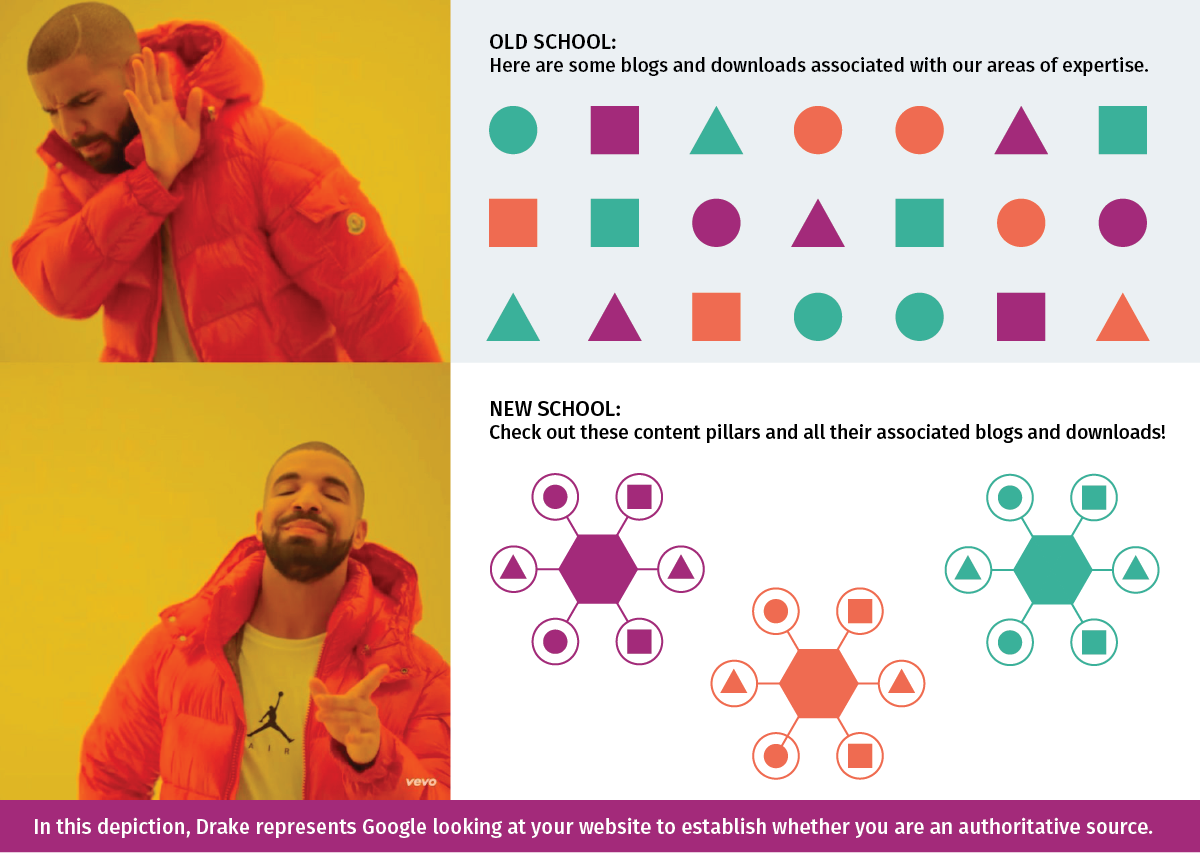Here at Little Bird, if there is one thing that we are all aware of it’s the fact that the world of marketing is constantly changing. We spend countless hours creating content through the process of well-defined strategies, only to discover that there is a new and improved way to do what we do.
That, my friends, is what has happened to SEO. Say hello to topic clusters! Wait, what the heck is a topic cluster? ...We'll get into that in just a moment, but first, it's important to understand why SEO is changing so drastically. You see, the way people search for information has changed, therefore, so has the strategy behind how to optimize for it. So strap in and don’t blink because we have a lot of information to cover and you won’t want to miss a thing!
Ch-ch-changes

Two major shifts have taken place over the last few years that have made a very big impact on the way we optimize for search engines:
- The way people search for information is changing
- Search engines have become better at interpreting and providing information
So, what does that mean for the marketer?
Thanks to recent advances in technology and the rise of voice search with devices such as Amazon Echo, Google Home, and Apple’s Siri, the way people find information has also changed. Gone are the days when you type simple and specific phrases into a search bar when asking a search engine for answers. In fact, search inquiries are becoming longer. People are asking for answers from search engines in a way that is more conversational, much like they would ask any person on the street.
Here’s an example: Not long ago, if you were here at the nest and had a sudden hankering for tacos, in order to get the most accurate results for your search, you might type something simple like, ”Tacos Joplin, MO”. It makes sense, right? However, these days if you were hungry for tacos you can simply whip out your iPhone and say, “Hey Siri, where is the best place to get tacos around here?” and like magic, you’re going to get a list of places near you that serve tacos. It’s seriously that simple. I know because I just checked ...and now I’m starving.
The statistics are pretty staggering. Here are just a few that will help put this change into perspective:
“There are over one billion voice searches per month. (January 2018)” estimates Alpine.AI
“40% of adults now use voice search once per day”
according to Location World
“60% of people using voice search have started in the last year” according to MindMeld
“50% of all searches will be voice searches by 2020”
according to comscore
This shift happened naturally. Not only because the use of technology in this way is becoming more and more common, but the quality of search results have dramatically improved and the quantity of content just keeps rising. In turn, people are trusting that when they ask things more vaguely, the result they will receive will still be just as (if not more) relevant. But, how does that affect your marketing strategy? I’m glad you asked.
The Death of Keywords
No, keywords aren’t actually dying. Though I’m sure that the headline grabbed your attention. Keywords are still a very important part of your content strategy. But, since search engines are getting smarter, the focus is no longer on the keywords, but the topics that those keywords fall under.
I’ll explain what I mean. Let’s begin with going through the SEO process that is and has been widely used by marketers for quite some time now.
It starts with doing extensive research on keywords that will match the topic of what you want your content to be about. You need something that is widely searched that won’t be too difficult to rank for. This part of the process takes some time and is constantly being refined. You then use “long-tail” versions of these keywords to create keyword phrases. Those keyword phrases become the anchor that all of your content is tied to. You put it in the URL of your web pages, in the titles and bodies of your blogs, use it in the alt text of your images, and in the meta description for your pages. This allows Google to recognize it as a relevant piece of information when someone types in a search inquiry with those keywords in it.
Keywords have been the heart of SEO for years. Companies have spent countless hours (and dollars) mastering the art of keyword strategy in an endless struggle to rank on search engine results pages, and good grief did some of them get good at it! To those that did, do not fear. You will still maintain authority as a source of information on those keywords. But, while they will still play a big role in the way you plan your content, it’s time that we, as marketers, stop thinking about our content in terms of just… words.
Say Hello to Topic Clusters
If not keywords, what are search engines using to determine a post's relevancy? Enter the Topic Cluster.
Google's search algorithm has gotten much smarter. It can now understand intent. It doesn’t have to match specific keywords in a search with the same words in a post anymore. This not only means searching for information is now easier, but results are going to become more and more relevant. So, what's actually happening when you search for answers?
In its simplest form, Google is searching for the topic of the inquiry. When it finds a piece of content that matches the topic of the inquiry, it then checks to see if the source of that content has authority on the topic. If you have multiple pieces of content supporting the same topic that are linked together, Google will recognize that. It then returns your content in the search results. This new way of organizing content is called a topic cluster. The goal now is not to anchor your content to a keyword, but to a topic.

So, where do you start when creating a topic cluster? Well, topic clusters are made up of two parts: Pillar Pages and Cluster Content.
A pillar page is the foundation on which a topic cluster is built. Pillar page content is more long-form because it completely covers the topic in a broad manner. It's intended to answer questions about the topic while leaving room for more detailed posts (cluster content) to further describe specific branches of the topic. This cluster content allows for an in-depth look at a specific branch of the topic. This is where keywords come into play. Using keywords that support your topic, you can then build content around your pillar page, and when hyperlinked back to the pillar page, it creates a topic cluster.
For example, if the topic was “baseball”, the pillar page would consist of all things baseball (it’s history, how it’s played, the culture, etc.), while cluster content might consist of things such as “how to throw a wicked curveball” or “understanding the rules of America’s greatest past-time”. The purpose is to rank for topics related to baseball. The pillar page acts as a guide to the basics of baseball, and the cluster content takes a deeper look into the specifics of a branch of baseball.
If done correctly, when a search inquiry is submitted the search engine will crawl over the different pages of your topic cluster and recognize the content as a relevant source of information on the topic. You will then be marked as a source that has some authority on the topic of the inquiry.
I know that this is a lot to take in. Just keep in mind that it’s fairly new for everyone. However, it is a positive change for both marketers and those we are trying to reach. I truly believe that with these changes, the future holds promise of easier searches, higher quality of information, and an overall better user experience with search.
As our team dives deeper into this new way of doing things we will be sure to share what we learn, along with providing examples of our own topic clusters. So stay tuned, because we are just getting started.
Do you want to know more about what all the future holds for inbound marketing? Of course you do!
Check out our guide to The Future of Marketing!
*We'd like to tell you that ALL businesses are concerned with growth, but only a Sith deals in absolutes.




Let Us Know What You Thought about this Post.
Put your Comment Below.